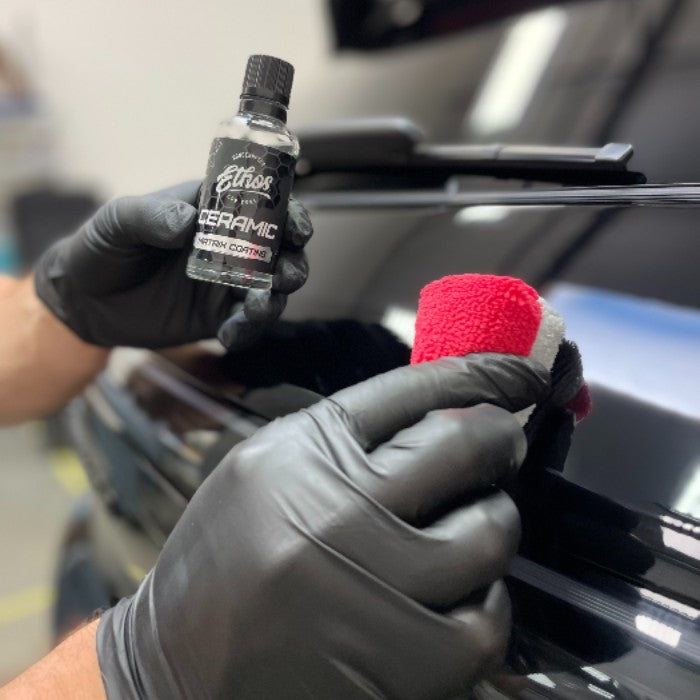How Ceramic Coating Newark can shield your vehicle from UV rays
Wiki Article
Checking out the Science Behind Car Ceramic Coating and Its Protective Properties
The science of car ceramic coating presents a remarkable study in sophisticated vehicle security. Composed largely of silicon dioxide and polymers, these layers form a robust bond with vehicle paint. This communication boosts toughness versus ecological threats while supplying hydrophobic benefits. Nevertheless, the details of how these coverings job and their long-lasting advantages continue to be much less understood. Unloading these information reveals why ceramic coverings are becoming a preferred selection for lorry treatmentWhat Is Ceramic Coating?
Ceramic coating is a liquid polymer that chemically bonds to the surface of a vehicle's paint. This sophisticated protective layer enhances toughness and uses remarkable resistance to environmental factors. Unlike conventional wax or sealers, which give short-term security, ceramic layers develop a lasting shield that can hold up against extreme conditions such as UV rays, acidic impurities, and severe climate. When applied properly, the coating creates a hydrophobic surface, causing water to bead and slide off, which aids in keeping the vehicle's sanitation. Additionally, it supplies boosted gloss and depth to the paint, making the vehicle appear even more polished and lively. The application process commonly includes comprehensive surface preparation, including cleansing and polishing, to assure peak bonding. Consequently, ceramic layers are ending up being increasingly prominent amongst car fanatics and those looking for to secure their financial investments, promising to maintain the automobile's aesthetic appeal while decreasing the frequency of maintenance.The Make-up of Ceramic Coatings
The detailed formula of ceramic finishes largely is composed of silicon dioxide (SiO2), which is obtained from natural resources like quartz and sand. This vital component supplies the foundation for the coating's longevity and protective high qualities. Along with SiO2, ceramic layers frequently include various polymers and additives that improve bond, adaptability, and resistance to environmental variables. These compounds work synergistically to produce a robust barrier against pollutants such as dust, chemicals, and UV rays.Furthermore, some formulations incorporate titanium dioxide (TiO2) or various other nanomaterials, which can boost the coating's hydrophobic residential or commercial properties, causing enhanced water repellency. The specific composition can vary considerably amongst suppliers, influencing efficiency and long life. Inevitably, the mix of these elements finishes in a protective layer that not just enhances the visual appeal of lorries however also offers to prolong their life-span by protecting the surface from prospective damages.Exactly How Ceramic Coatings Work
Comprehending exactly how ceramic finishings work involves discovering their chemical make-up, which adds to their protective qualities. The application procedure is crucial for attaining suitable outcomes, while durability and longevity elements establish the coating's effectiveness over time. With each other, these aspects highlight the benefits and efficiency of ceramic finishes for car security.Chemical Structure Explained
While numerous car owners seek resilient security for their automobiles, the chemical make-up of ceramic coverings plays a critical duty in their effectiveness. These finishings largely include silicon dioxide (SiO2), which is acquired from natural minerals. This compound forms a strong bond with the vehicle's paint, developing a long lasting, safety layer. Furthermore, numerous ceramic layers include titanium dioxide (TiO2), boosting their hydrophobic buildings and resistance to UV rays. The presence of polysiloxanes can even more enhance adaptability and sturdiness. With each other, these elements add to the coating's ability to ward off water, dirt, and pollutants, while additionally supplying a high-gloss surface. Recognizing this chemical structure assists car proprietors appreciate the robust defense provided by ceramic coverings.Application Process Summary
Applying ceramic coatings entails a meticulous process that ensures suitable bonding and protection for the car's surface area. At first, thorough cleaning and purification of the car's outside are performed to eliminate dust, grime, and previous waxes. This step verifies that the surface is without impurities that could impede bond. Following this, the paint is usually brightened to enhance clearness and eliminate any kind of blemishes. Once prepared, the ceramic coating is applied in tiny dig this areas using an applicator pad, enabling for consistent coverage. The coating is after that left to heal, developing a solid chemical bond with the surface area. Correct treating times and problems are crucial, as they validate the coating achieves its maximum efficiency and protective top qualities.Durability and Durability Elements
Ceramic finishings are made to give resilient defense with their sophisticated chemical composition, which develops a robust barrier versus environmental pollutants. The resilience of these layers is influenced by factors such as the density of the application, the high quality of the product, and the conditions under which the vehicle is subjected. Top notch ceramic finishes can last numerous years, withstanding scrapes, UV rays, and chemical discolorations. Correct maintenance, consisting of normal washing and regular reapplication, can better improve long life. In addition, environmental factors like climate and exposure to pollutants can affect the life-span of the coating. Generally, when applied and kept appropriately, ceramic coatings provide exceptional durability, making them a prominent selection for car lovers looking for to preserve their vehicle's look.Hydrophobic Qualities and Water Repellency
Hydrophobic homes are a trademark of top quality car ceramic finishings, substantially improving the vehicle's surface area performance. These layers develop a molecular bond with the car's paint, resulting in a surface area that repels water successfully. When water comes right into call with a ceramic-coated surface, it beads up and rolls off, decreasing the quantity of fluid that stays on the paint. This actions not only adds to an aesthetically pleasing look yet likewise reduces the accumulation of contaminants such as dust, gunk, and roadway salts.The enhanced water repellency brings about much easier cleaning and upkeep, as much less initiative is needed to remove unwanted substances. On top of that, the hydrophobic nature of ceramic finishes helps in avoiding water areas, which can mar the surface of uncoated surfaces. In general, the consolidation of hydrophobic properties in ceramic coatings plays a vital function in preserving the vehicle's beautiful look while simplifying upkeep.Protection Against Scratches and UV Damages
Car ceramic coatings provide substantial defense against scrapes and UV damages. The scratch resistance system produces a sturdy layer that takes in influences, while the UV securing advantages assist preserve the automobile's paint honesty gradually. With each other, these attributes add to a longer-lasting and aesthetically appealing finish.Damage Resistance System
Using advanced modern technology, ceramic coverings give a robust guard against scrapes and UV damage, boosting the durability and look of car surface areas. The scratch resistance device of these coverings is credited to their one-of-a-kind molecular framework, which creates a sturdy bond with the lorry's paint. This bond develops a hard, safety layer that can take in impacts and withstand abrasions. In addition, the smooth surface area of the coating reduces rubbing, making it challenging for impurities to adhere and create scratches. The chemical structure of ceramic coverings frequently includes nanoparticles that enhance the protective layer, more enhancing its resilience. Vehicles treated with ceramic finishings show substantially enhanced scrape resistance compared to standard wax or sealers, making certain a beautiful coating over time.UV Protecting Conveniences
The see this here safety top qualities of ceramic layers expand past scrape resistance to include considerable UV protecting advantages. These coatings develop a durable obstacle that mirrors unsafe ultraviolet rays, guarding the vehicle's paint click site and underlying materials. Long term direct exposure to UV radiation can lead to fading, oxidation, and wear and tear of the paint finish. By integrating ceramic coverings, lorry proprietors can effectively minimize these dangers, protecting the aesthetic appeal and integrity of their vehicles. Additionally, the UV blocking buildings add to boosted long life, lowering the regularity of painting and upkeep. Eventually, the integration of ceramic coatings provides an extensive solution for securing vehicles from the damaging impacts of sun direct exposure, ensuring a continual, dynamic appearance with time.The Durability and Upkeep of Ceramic Coatings

Frequently Asked Concerns
Can Porcelain Coating Be Applied to Any Kind Of Sort Of Automobile?
Ceramic coating can be related to various kinds of lorries, including vehicles, trucks, and motorbikes. Nonetheless, surface area preparation and compatibility with specific materials are vital for excellent adhesion and effectiveness of the coating.Just How Much Does Ceramic Coating Normally Cost?
Ceramic coating usually sets you back in between $500 and $2,000, depending on elements such as automobile dimension, coating high quality, and specialist application. The investment can offer durable security and improve the automobile's look gradually.
Is Specialist Application Necessary for Ideal Results?
The need of professional application frequently depends on desired outcomes. Specialists normally assure appropriate surface preparation and application strategies, bring about excellent bonding and long life of the coating, which might be challenging for inexperienced people to attain.Can Porcelain Coatings Be Eliminated or Repaired?
Ceramic coatings can be gotten rid of or repaired, though the process might need particular solvents or techniques - Ceramic Coating Newark. Correct removal is necessary to stay clear of damage to the underlying surface, stressing the relevance of specialist help for ideal resultsExactly How Does Ceramic Coating Compare to Standard Wax?
The comparison in between ceramic coating and conventional wax exposes that ceramic layers offer remarkable toughness, enhanced security against ecological impurities, and longer-lasting sparkle, while wax needs much more constant application and provides much less general resistance to damages.Report this wiki page